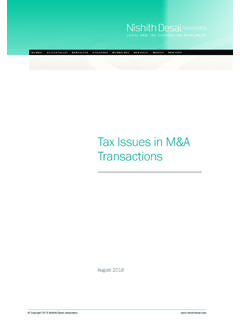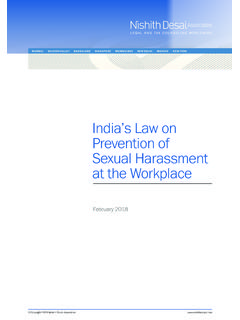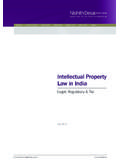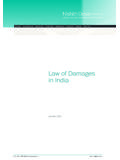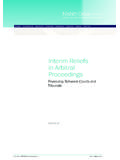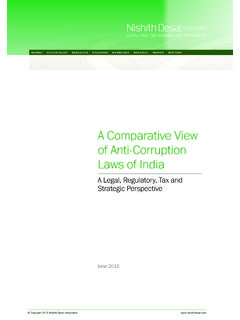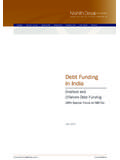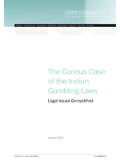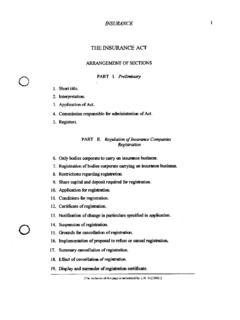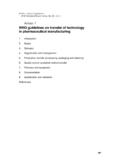Transcription of Insurance Law Regulations in India [ ] [ ][ ][ ]
1 ][][][][[]& Insurance Law Regulations in IndiaFor Private Circulation Only Nishith Desai Associates, 2002 Nishith Desai AssociatesLegal & Tax Counselling MITTAL COURT, NARIMAN POINT, MUMBAI 400 021. INDIATEL: 91 (22) 282-0609, FAX: 91 (22) 287-5792220 CALIFORNIA AVENUE., SUITE 201, PALO ALTO, CA 94306, USATEL: 1 (650) 325-7100, FAX: 1 (650) 325-7300 MUMBAISILICON VALLEYI nsurance Law & Regulations in India Parveen Nagree-MahtaniThe author would like to thank Sandeep Farias for the invaluable advice and professional guidance, and acknowledge the assistance of Suman Reddy and Pavan Kumar Duvva. Nishith Desai AssociatesLegal & Tax Counseling AND GROWTH OF THE Insurance INDUSTRY IN of the Insurance Industry in of the Insurance Business in of Private Regulatory and Development Advisory Association of India , Councils and OF AN Insurance Registration Structure for obtaining a certificate of of of of certificate of of of Assets Liabilities and Solvency of Returns Advertisements to the Rural and Social Sector and Nomination Exchange laws laws Surveyors and Loss Party Insurance22 Content][[]][][][]
2 [Nishith Desai AssociatesLegal & Tax Counseling OF Insurance and Subrogation Cause and Consumer of Insurance Policy27 Content][[]][][][][Nishith Desai AssociatesLegal & Tax Counseling Worldwide][The concept of Insurance has been prevalent in India since ancient times amongst Hindus. Overseas traders practised a system of marine Insurance . The joint family system, peculiar to India , was a method of social Insurance of every member of the family on his life . The law relating to Insurance has gradually developed, undergoing several phases from nationalisation of the Insurance industry to the recent reforms permitting entry of private players and foreign investment in the Insurance industry. The Constitution of India is federal in nature in as much there is division of powers between the Centre and the States.]
3 Insurance is included in the Union List, wherein the subjects included in this list are of the exclusive legislative competence of the Centre. The Central Legislature is empowered to regulate the Insurance industry in India and hence the law in this regard is uniform throughout the territories of development and growth of the Insurance industry in India has gone through three distinct stages. Insurance law in India had its origins in the United Kingdom with the establishment of a British firm, the Oriental life Insurance Company in 1818 in Calcutta, followed by the Bombay life assurance Company in 1823, the Madras Equitable life Insurance Society in 1829 and the Oriental life assurance Company in 1874. However, till the establishment of the Bombay Mutual life assurance Society in 1871, Indians were charged an extra premium of up to 20% as compared to the British. The first statutory measure in India to regulate the life Insurance business was in 1912 with the passing of the Indian life assurance companies Act, 1912 ( Act of 1912 ) (which was based on the English Act of 1909).
4 Other classes of Insurance business were left out of the scope of the Act of 1912, as such kinds of Insurance were still in rudimentary form and legislative controls were not considered necessary. General Insurance on the other hand also has its origins in the United Kingdom. The first general Insurance company Triton Insurance Company Ltd. was promoted in 1850 by British nationals in Calcutta. The first general Insurance company established by an Indian was Indian Mercantile Insurance Company Ltd. in Bombay in 1907. Eventually, with the growth of fire, accident and marine Insurance , the need was felt to bring such kinds of Insurance within the purview of the Act of 1912. While there were a number of attempts to introduce such legislation over the years, non- life Insurance was finally regulated in 1938 through the passing of the Insurance Act, 1938 ( Act of 1938 ).
5 The Act of 1938 along with various amendments over the years continues till date to be the 1definitive piece of legislation on Insurance and controls both life Insurance and general Insurance . 2 General Insurance , in turn, has been defined to include fire Insurance business , marine Insurance 34business and miscellaneous Insurance business , whether singly or in combination with any of of the Insurance Industry in India 1 Section 2(11), Insurance Act, 1938: life Insurance Business means the business of effecting contracts of Insurance upon human life , including any contract whereby the payment of money is assured on death (except death by accident only) and the happening of any contingency dependent on human life , and any contract which is subject to payment of premiums for a term dependent on human life and shall be deemed to include (a)the granting of disability and double or triple indemnity accident benefits, if so provided in the contract of Insurance ;(b)the granting of annuities upon human life .
6 And(c)the granting of superannuation allowances and annuities payable out of any fund applicable solely to the relief and maintenance of persons engaged or who have been engaged in any particular profession, trade or employment or of the dependents of such persons. 2 Section 2(6-A), Insurance Act, 1938: Fire Insurance business means the business of effecting, otherwise than incidentally to some other class of Insurance business, contracts of Insurance against loss by or incidental to fire or other occurrence customarily included among the risks insured in fire Insurance Section 2(13-A), Insurance Act, 1938: Marine Insurance Business means the business of effecting contracts of Insurance upon vessels of any description, including cargoes, freights and other interests which may be legally insured, in or in relation to such vessels, cargoes and freights, goods, wares, merchandise and property of whatever description insured for any transit by land or water, or both, and whether or not including warehouse risks or similar risks in addition or as incidental to such transit, and includes any other risks customarily included among the risks insured against in marine Insurance Section 2(13-B), Insurance Act, 1938: Miscellaneous Insurance business means the business of effecting contracts of Insurance which is not principally or wholly of any kind or kinds included in Section 2 (6-A), (11) and (13-A) of the Insurance Act, 1938.
7 []1 Development & Growth of the Insurance Industry inIndia][ ][Nishith Desai AssociatesLegal & Tax Counseling Worldwide][ of the Insurance Business in of Private PlayersOn January 19, 1956, the management of life Insurance business of two hundred and forty five Indian and foreign insurers and provident societies then operating in India was taken over by the Central Government. The life Insurance Corporation ( LIC ) was formed in September 1956 by the life Insurance Corporation Act, 1956 ( LIC Act ) which granted LIC the exclusive privilege to conduct life Insurance business in India . However, an exception was made in the case of any company, firm or persons intending to carry on life Insurance business in India in respect of the lives of persons ordinarily resident outside India , provided the approval of the Central Government was obtained. The exception was however not absolute and a curious prohibition existed.
8 Such company, firm or person would not be permitted to insure the life of any person ordinarily resident outside India , during any period of their temporary residence in India . However, the LIC Act, 1956 left outside its purview the Post Office life Insurance Fund, any Family Pension Scheme framed under the Coal Mines Provident Fund, Family Pension and Bonus Schemes Act, 1948 or the Employees' Provident Funds and the Family Pension Fund Act, general Insurance business was also nationalised with effect from January 1, 1973, through the introduction of the General Insurance Business (Nationalisation) Act, 1972 ( GIC Act ). Under the provisions of the GIC Act, the shares of the existing Indian general Insurance companies and undertakings of other existing insurers were transferred to the General Insurance Corporation ( GIC ) to secure the development of the general Insurance business in India and for the regulation and control of such business.
9 The GIC was established by the Central Government in accordance with the provisions of the companies Act, 1956 ( companies Act ) in November 1972 and it commenced business on January 1, 1973. Prior to 1973, there were a hundred and seven companies , including foreign companies , offering general Insurance in India . These companies were amalgamated and grouped into four subsidiary companies of GIC viz. the National Insurance Company Ltd. ( National Co. ), the New India assurance Company Ltd. ( New India Co. ), the Oriental Insurance Company Ltd. ( Oriental Co. ), and the United India assurance Company Ltd. ( United Co. ). GIC undertakes mainly re- Insurance business apart from aviation Insurance . The bulk of the general Insurance business of fire, marine, motor and miscellaneous Insurance business is undertaken by the four 1956, with the nationalization of Insurance industry, the LIC held the monopoly in India 's life Insurance sector.
10 GIC, with its four subsidiaries, enjoyed the monopoly for general Insurance business. Both LIC and GIC have played a significant role in the development of the Insurance market in India and in providing Insurance coverage in India through an extensive network. For example, currently, the LIC has a network of 7 zones, 100 divisions and over 2,000 branches. LIC has over 550,000 agents and over 100 million lives are covered. From 1991 onwards, the Indian Government introduced various reforms in the financial sector paving the way for the liberalization of the Indian economy. It was a matter of time before this liberalization affected the Insurance sector. A huge gap in the funds required for infrastructure was felt particularly since much of these funds could be filled by life Insurance funds, being long tenure funds. Consequently, in 1993, the Government of India set up an eight-member committee chaired by Mr.


